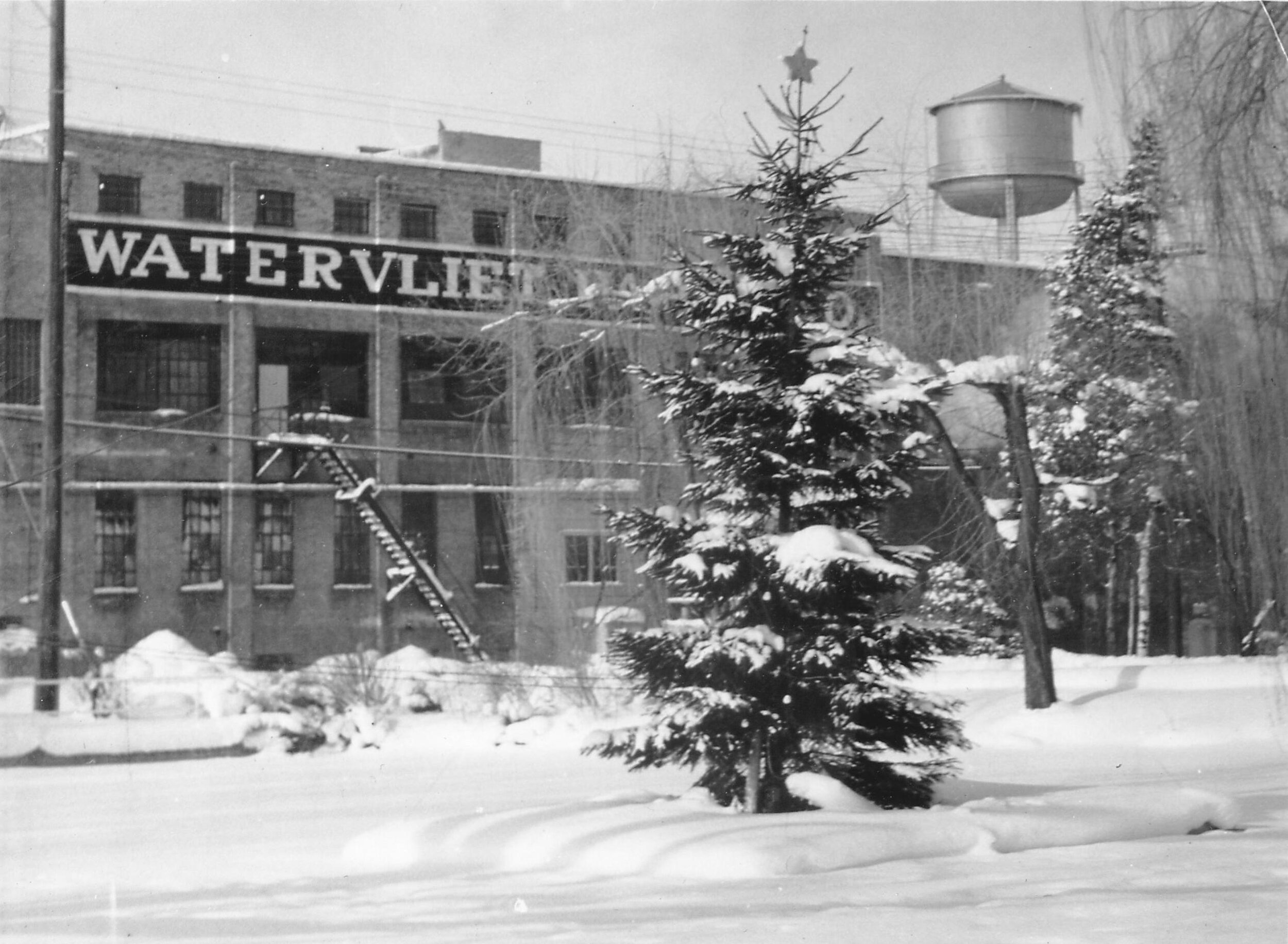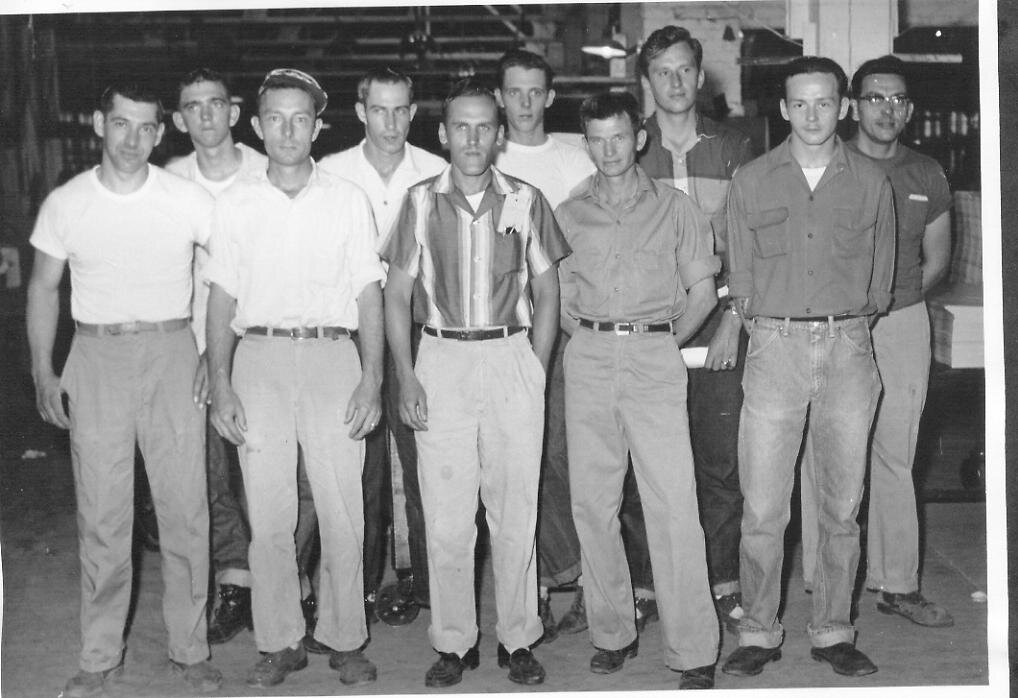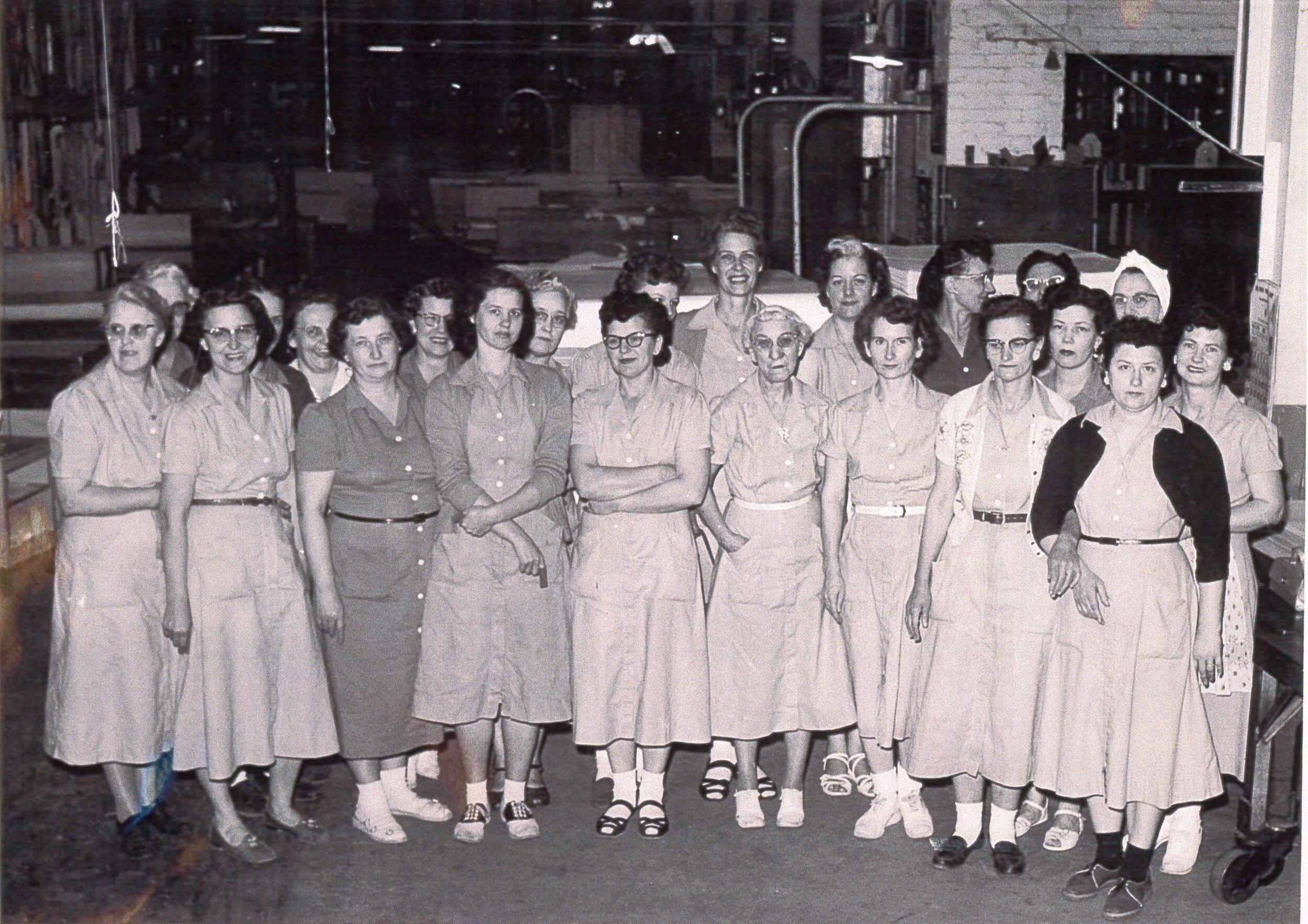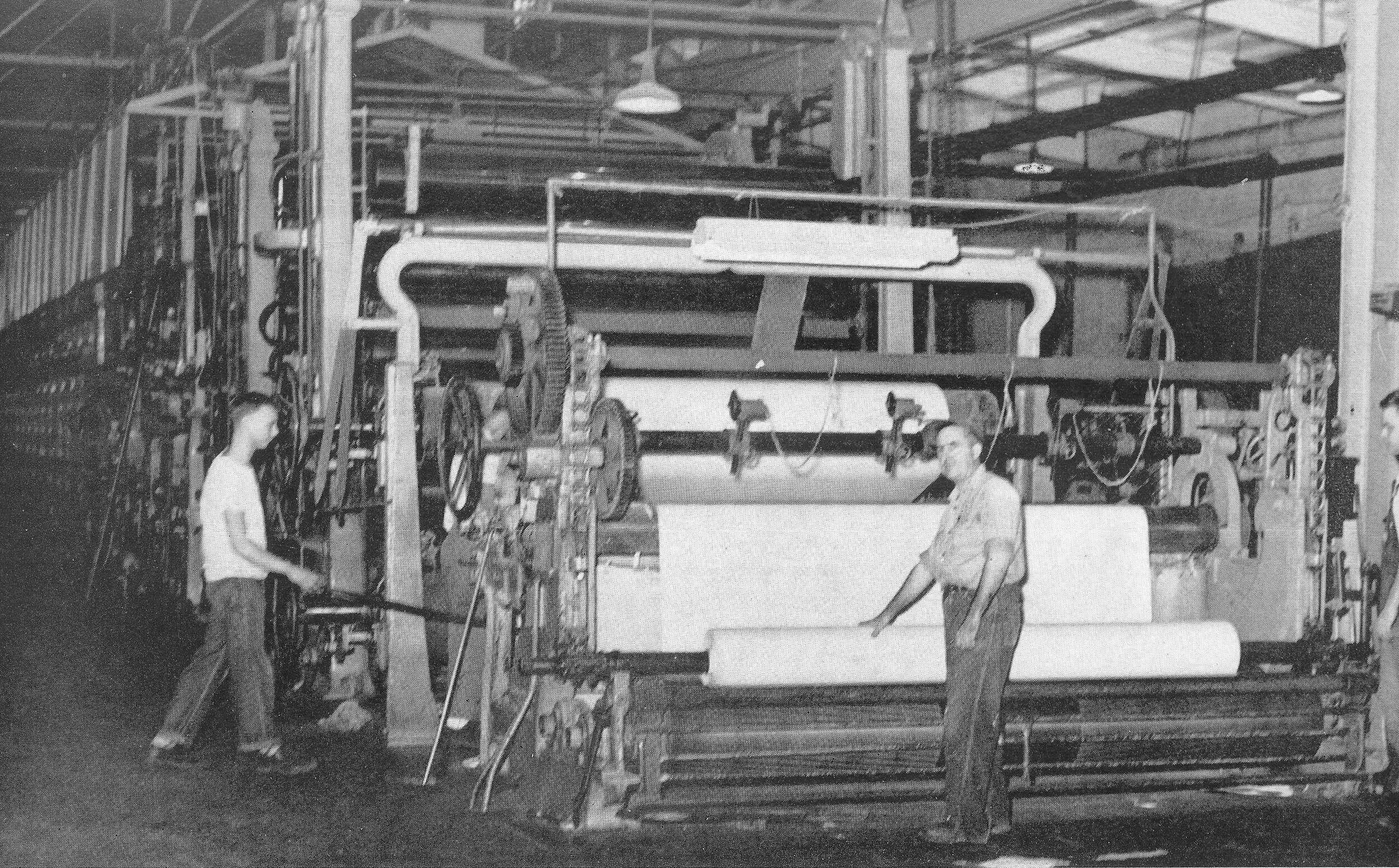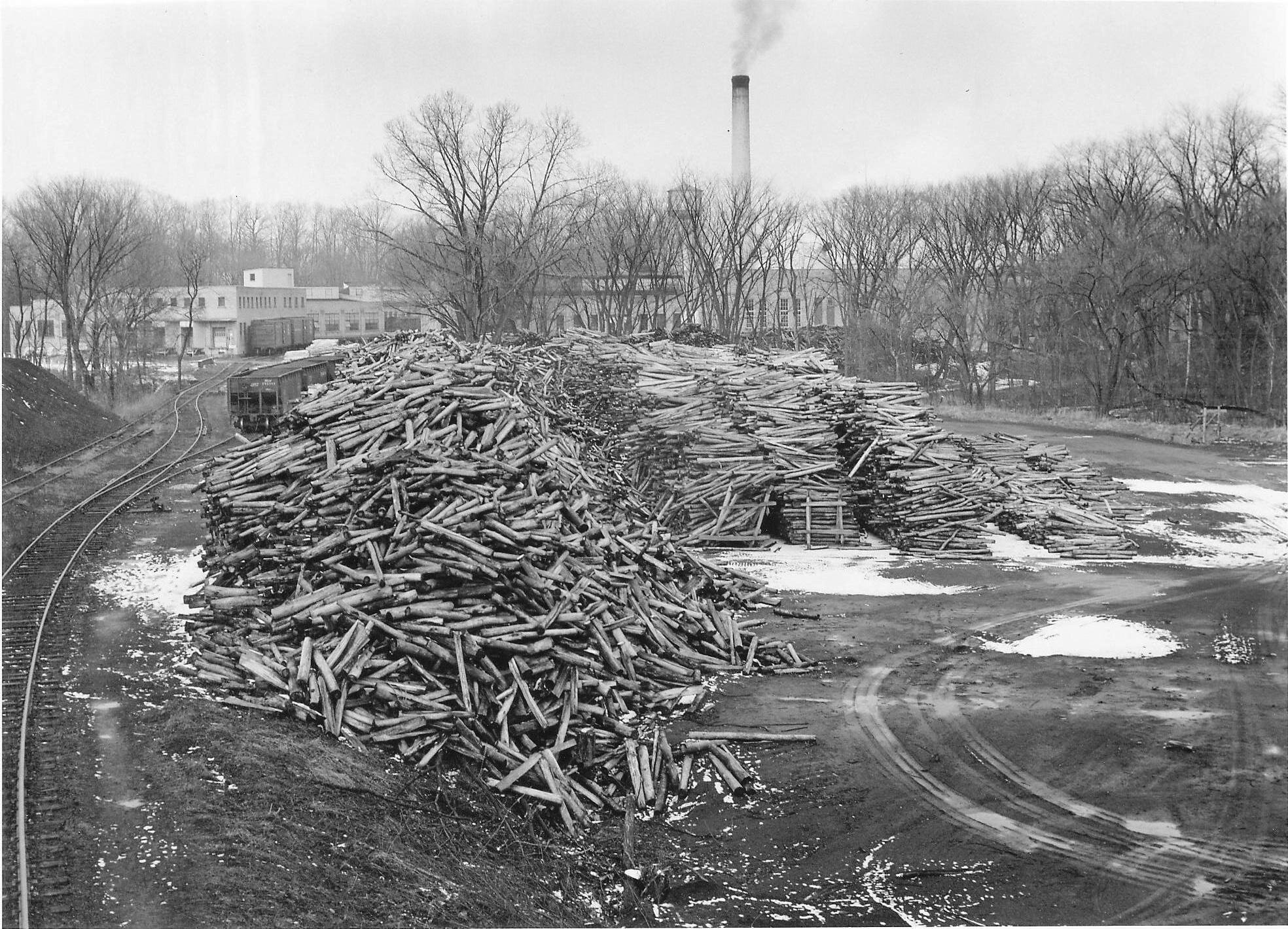Watervliet Paper Mill
The flow of the Paw Paw River powered the earliest lumber mills near this site with the help of dams by the late 1830s and local timber was depleted after a few decades. A brick paper mill was built on the former site of a saw mill and first began operating in 1894, but was closed by 1905. The Watervliet Paper Company was formed in 1910, primarily by Kalamazoo investors. The paper mill here was considered “one of the best constructed plants ever erected” in Michigan, so it was re-opened with renovations and new state-of-the-art machinery. In 1912, the Watervliet Paper Company (WPC) began making fine glossy or “coated” paper products. A rail spur connected the paper mill to the railroad in town, allowing the WPC to easily bring in pulp sources and ship out its finished products.
WPC quickly gained a reputation for quality and consistency. Paper made in Watervliet was used around the nation as catalog covers, including Sears, Roebuck, & Co., as well as labels and wrappers in goods such as Wrigley’s Gum, Campbell’s Soup and Kodak Film. The mill also produced U.S. postage stamps and large amounts of playing cards. Hundreds of workers drove the success of WPC-in 1960 the payroll included 470 employees. It was not only the area’s largest employer, its significant contributions to local taxes helped fund the fire and police services, schools and the hospital in Watervliet. WPC sponsored leisure activities like baseball and bowling teams, musical groups, an employee newsletter, annual parties and social events. The paper mill shaped everyday life for local residents and generations of workers.
Throughout its early history the paper mill was powered by a combination of water wheels and steam engines, and used large amounts of river water for paper making. In 1973 the mill introduced a new water use and recycling system that prevented any further impact on the Paw Paw River. WPC became a part of Hammermill Paper in 1956, then it changed hands again four times after 1974. The paper mill produced its last paper in 1994 and was demolished in 2002, ensuring the total clean-up of hazardous wastes at the site. The historic dam structures remained in place until 2011, when the natural flow of the Paw Paw River was restored.
Mill Employee List
Percy Abbott
John M. Ackerman
Milford Ackerman
Paul Ackerman
Esther Achorn
Robert G. Adams
Jerry Admave
Joan Admave
Reginald Admave
Jerry Alexander
Charles Allen
Linda Ament
Larry Anchor
Dorothy Anderson
Douglas Anderson
Timothy Anderson
William Anderson
James Andres
Judy Andres
Randy Antio
George Apple
Roger Applegate
Grace Mann Berchin Armstrong
Myrl Arnold
Gilbert Arrans
Beverly Atherton
Harvey Atherton
Robert Atherton
William Atherton
Patrick Aviles
Timothy Axsom
Anthony Azzarola
Richard Bachman
David Backus
Elsie Backus
Fred Backus
Fred Bahrenburg
Beryl Bailey
Lester Bailey
Francis Bailey
Mildred Bailey
Ralph Bailey
Roy Bailey
Irma Sieber Baker
John Baker
Ronald Baker
Dennis Bakken
chuck bailey
James B. Balch
Severens Balch
Don Baldwin
emzley baldwin
Laura Baldwin
Richard Baldwin
otis baldwin
Sharon Bale
Alma Bandurske
Edward Bandurske
Don BanE
Walter Barchet
Carmen Barchett
Jasper Barker
Vernon Barker
Suszanne Barnak
Pat Barrett
Jane Bates
Paul Bates
Robbie Bates
Nelson Baumeister
Earl Beam
Lillian Beam
Berl Beavers
Ingar Becht
Garland Beck
Jeanette Beck
Melvin Beck
Merlyn Beebe
Lester Beeman
Milton Beeson
Joseph “Joe” Berchin
Bobby Berry
Paul Berry
Malcolm Bertorelli
Herman Bettig
Roger Bettig
Frank Bielby
Wayne Bigelow
Carole Birmele
Edward Birmele
Raymond Bisbo
Matilda Mensinger Bischoff
Augustus Bisbee
Nyle Bisbee
Chauncey Bishop
Lyman Bittner
Jim Blake
Clara Blanshan
Hubert W. Blevins
Mary Blevins
Vicki Blevins
Galen “Skip” Blough
Duane Bodfish
Clinton Bohannon
Laurence Boomer
Raymon Bowden
Dwight Boyer
Forest boyer
Gertrude Boyer
James Bradt
Cecil Branch
Lawrence Brassard
B. L. Brayton
Nicholas Breidinger
Nettie Stickney Brink
Charles Brock
Linda Brooks
Donna Brower
Kenneth Brower
Millard Brower
Lowell Brown
Verna Brown
Stanley Brown
Walter Brown
Wanda Brunner
Dean Brunt
Darold Budd
Tom Budd
Harold Bulger
Jack Bultema
Charles Bunn
Jerry Bunn
Joseph Bunn
Ross “Billy” Burger
Evin Burton
Robert Burnsworth
Harry Bushick
Lottie Bushick
John H. Calder
Kenneth Callahan
Henry Callard
Elmer Callender
Dorothy Mishler Camp
Ed Camp
Thomas Campbell
Primo Capovilla
Eleanor Caprez
Rodney Caprez
Anthony Carolla
Loretta Carmody
Robert Carmody
Anthony Carolla
Isaac Carpenter
William Carpenter
James Carter
Tim Carter
James E. Cartwright
James L. Cartwright
Nancy Cartwright
Michael Case
Carl Casey
Edward Casey
Ray Cerney
Robert Cerney
C. J. Chamberlin
Kenneth Chambers
Judon Chandler
Dessie Chappel
Steve Chappel
Eugene Chaput
Frances Chaput
Robert Chaput
Charles Chase
William Cheney
Richard Chernugel
Joseph Cheshire
Jerry Clark
Russell “Rush” Clark
Delores Classen
Raymond Classen
June Clauss
Charles Clay
Viola Clay
Dennis Clayton
Corydon “Butch” Clemens
Earl Clinard
Verl Cobb
William Cobb
Aaron Cobbs
Beverly Cole
Ray Cole
Kathleen Coleman
Thomas M. Collins
Ward Collins
Robert Comp
James D. Cook
Barlo Coon
James Cooper
Carol Cornell
Russell Cote
Duane Cowgill
Thomas Cowgill
Verlyn Cowgill
Joseph Crady
Kenneth Craig
Randy Craig
Sherry Craig
Fred Cretors
Edward Cripe
Delbert Cromer
Joe Cross
Larry Crowder
Mike Crowder
Albro Crumb
Arthur Crumb
Ralph Crumb
Floyd Curtis
Larry Curtis
Albert Dahmas
Buff Dale
Helen Dale
Lannie Damoth
Jay Daniels
Norman Daniel
Clarence Danneffel
Stanley Danneffel
Ward Danneffel
George Darling
George Darling, Jr.
Paul Darling
Thomas Darling
Clarence Daugherty
Mark Prescott Daugherty
Sherrian Daugherty
Thomas Daugherty
Alora Davis
George Davis
Howard Davis
Ida Davis
Leslie Davis
Lewis Davis
Linford Davis
R. William Davis
Darrell Day
Susan Day
Alfonzo Decker
Daniel L. Decker
Elmer DeFord
Terry L. DeFord
William DeFord, Jr.
Henry Dell
Laura Pumfery Dell
Norman DeLoach, Jr.
Floyd DeMars
Harold DeMay
Betty Diebold
Deborah Diebold
John Diebold
Kirk Diebold
Paul Diebold
Larry Dillenbeck
Max Dillenbeck
Carl Dixon
Carol Lange Dlouhy
Herbert Doberstein
Frank Dockter
Mike Dolezan
Patrick Dolph
Agatha Healy Donovan
Elaine Doornbos
Robert Dotson, Jr.
Michael Double
Woodrow Downey
David Downs
Avery Draime
William Drake
George Dublin
Vester Dublin
Keith Duffield
Russell Dunning
Robert Durfee
Audas L. Durflinger
Glenn L. Durflinger
Jonas W. Durflinger
Frances Dykas
Charles Edwards
Jerry Edwards
Joseph Eftink
James Eisbrenner
Lisa Elston
Paul Emerson
Franklin Emery
Melvin Emery
Thomas Emery
James Empson
John Empson
Joyce Empson
Arthur Enos
James Eubanks
Casey Evans
Joe Eveland
Ted Eveland
Reola Aldean “Dean” Evett
Herbert Faram
Joseph Salvatore Faraone
Sally Farley
Spencer Fay
William Fay
Dale Fenters
George K. Ferguson
Harold Ferguson
Richard Fester
Alden W. Field
Adolph Fietz
Harry Fietz
Efrain Figueroa
Chellace Fish
Roger Fisher
Merle Fitzpatrick
William Fizzell
Leonard Flagel
Robert Flagel
Chelmyrle Foltz
William Forbes
Dennis Forrester
Thelma Forrester
Richard Fox
Arthur Frank
Oscar Franklin
Johnnie Franks
Floyd Frazee
Art Frazier
Arvid Frazier
Thomas Frazier
Wilson Frazier
Donald Frazier
Nancy Frazier
Dorothea Freck
Val Friedrich, Jr.
Dan Frietas
Harriet Frietas
Pauline Frieze
Reinhold Frieze
Terry Fritz
Debra Fuller
Glenn Fuller
Harry Fuller
Harry F. Fuller, Jr.
John Fuller
John Fuller, Jr.
Robert G. Fuller
Michael Fullriede
William A. Furlan
C. Michael Gadberry
Regina Gagliano
Steve Gagliano
Roman Gajewski
Jordan Gallagher
Jorge Gallegos
Ila Gardner
Philip Gargano
Clayton Garrison
Rosella Gatchell
Edward Walter Gay
Paul Gay
Wayne Gay
Donald Gearing
Sherry Gifford
Donald Gibbs
M. Wayne Gilbert
John Giese
George Gillard
E. H. Gilman
Pete Giunta
Tim Gladysz
Henry Gnewuch
Jack Gnewuch
Bobby Godgiben
Dwayne Goodrich
Donnie Gordon
Loris Goss
Victor Granada
Danny Gray
Leslie Grays
Anthony J. Greco
Dominick Greco, Jr.
Lillian Greco
Joseph Greco
Tim Greco
Tom Greco
Tony Greco
Jerry Gregory
George Grenon
Mary Griffin
Robert Griffin
Kenny Groth
Laura Groves
Robert Gulliver
Thomas Gunter
John Gustafson
John Hadley
Richard Hall
Robert Hall, Jr.
Marjorie Halley
Lee Hamilton
Norman Hammons
Norman Hammons, Jr.
David Haney
Murl Haney
Wesley Haney
Frank Hanks, Jr.
Adolph Hann
Dorothy Hansen
Edward Harbin
Virgil Hardy
Robert Harkey
Dixie L. Harmon
Darleen Harper
Douglas Harper
Elizabeth Harper
Eugene Harper
George Harper
Leo Harper
Merlin Harper
Dale Harris
Dan Harris
dannie Harris
Della Harris
Doris Harris
Doyce Harris
Frank Harris
Ken Harris
Lee Harris
Russell Harris
Charles Hart, Jr.
Lindell Hart
Robert Harvey
Ronald F. Hauch
Bonnie Haus
Donald Haus
Charles B. Hays
Leo Healy
Ethel Hedlund
L.D. Heflin
Paul Heimsath
Claudia Heiser
Robert Henderson
William Hendricks
Jack Henry
Donald Hentschel
J. D. Hentschel
Mary Herman
Norman Hester
Ross Hicks
Dale Hill
Dwigh Herrick
Phillip Hild
William Hilliard
Grace Hinckley
Marion Hinton
Ruth Hinton
Dorothy Hoadley
Gerald Hoadley
Claud Hobson
John Hodge
John Hodge, Jr.
John Hodge III
Larry Hoenes
John Hoffman
Larry Holland
Robert Hogue
Edith Hondorp
Norman Horney
William Horney
Bobbie Horton
Dwight Horton
Harriet Hosang
William A. Houart
Roy Hough
Kenneth Howard
Laurence Howe, Jr.
Herbert Howell
John Howley
John R. Howley
Harvey Hoyt, Jr.
Kerry Haus
Vermon Haus
Charles Huckaba
Gary Huddleston
George Huffman, Jr.
Wilbur C. Hunting
Arthur Hupp
roswell hupp
Robert Huston
G. W. Hutchins
Jeffery Hutchins
Joe Hutchins
Robert Hutchins
William Hutchins
Charles A. Hyde
Harold Icenogle
Roger Igert
Deloris Iliff
Robert Iliff
Johnny Imler
Adeline Ishmael
Grace Ishmael
Lawerence Ishmael
Walter Ishmael
John E. Jaco
Kenneth Jacobs
Michael Jacobs
Michael A. Jacobs
Stanley Jackson
Thomas R. Jackson
Walter Jackson
Richard Jarvis
Robert Jarvis, Sr.
Robert Jarvis, Jr.
Michael Jennings
Niels K. Jensen
David Jinkins
David Johnson
Demarius Healy Johnson
Fred Johnson
James Johnson, Jr.
Jim Johnson
Lorraine B. Johnson
Ruth Johnson
Travis Johnson
Robin Jollay
Elna Jonas
Dale Jones
Paul Jones
Joseph Jordan
Thomas Jordan
Franklin Katje
John Kelemen
Dickie Keller
Eda Keller
Linda Kelley
Mark Kellogg
Clifford Kelly
Oliver Kelly
William Kelly
Porter Kendall
John Kendzior
Thomas Kendzior
Jerry Kern
Frank R. Kibler
Alleyne Kietzer
Carl Kietzer
Frances Kietzer
Gertrude Kilmark
Howard Kimball
S.B. Kimball
Richard Kimp
Ronnie V. Kinchen
Andrew “Andy” King
Buell King
Lucius King
Stanley King
Vick Kinzler
John Klann
Lori Klann
Claude Knapp
Regis Kniebes
Roger Knight
Roy Knight
Samuel Knight
Sherman Kniss
Cynthia Knuth
Leonard Kolberg
John Kolenko, III
John Kolenko, Jr.
Paul Kolenko, Sr.
Pete Koshar
Peter J. Koshar
Stanley Kowitz
James Kraklau
Carl Kreitner
Wayne Kreitner
William Kreitner
Eva Krenzien
Chris Krieger
George Krieger
Karen Krieger
Keith Krieger
Rod Krieger
Bertha Mensinger Kroening
Bill Kroening
Donald Krogel
Roy Kuehnle
Richard Lamb
Andrew Langston
Glenen Langston
Michael Langston
Paul Langston
John LaPlant
Aage Woodward Larsen
Wayne Larsen
Scott M. Larson
Bradley Latham
Billy Latham
Sherry Latham
Clara Sieber Latislaw
Stanley Laws, Jr.
Clarence Latislaw
Emil Laviolette
George Lawton
Phil Le Monte
Don Lea
Brian Lechenet
Ernest Lembke
F. A. Lemke
James A. Leonard
James N. Leonard
Nate J. Leonard
R. A. LeRoy
Kate Lewis
Fred Liebers
George Liles
Jimmy Liles
Adolph Lindemann
Donald Lindemann
C. B. Lindstron
Ernest Linton
Wayne Little Sr.
Pamela Lloyd
John Lockner
Alice Long
John “Jack” Long
Leon Long
Richard Long
Roscoe Long
Art Loomis
Carl Loomis
Harold Loomis
John Loomis
Lester loomis
Robert loomis
Robert t. loomis
Thomas Lopresti
Harold Lottridge
Jack Lottridge, Jr.
Walter Love
Robert Lovell, Sr.
Kenneth Lowe
Randy Lowe
Fred Lull
Hubert Lyle
Arlie Lynch
Darryl Lynch
James Lynch
James Lynch, Jr.
Patrick Lynch
Rodney Lynch Sr.
Arthur Franklin Martin Sr.
Dale Martin
Marsha Summerhill Maynard
Craig McClelland
George McCloud
Michael McCloud
Bob McConnell
Billy McCoy
Twila McGowan McCoy
Carl McCuan
David McFall
LeRoy McGath
Bill McGee
James McGee
Michael McGee
Thomas McGee
Millard McGowan
Addie McKean
Clay McKean
LeRoy McKean
Stanley McKean, Sr.
Stanley McKean, Jr.
Joe McKenzie
Dean McKinney
Ranse McKinney
Russell McNealy
Carl McNees
Charles McNees
Don McNees
James McNees
Leo McNees
Raymond McNees
Clinton McVay
Edward McVay
Joseph “gene” McVay
Mary McVay
robert mcvay
Woodrow McVay
Orville Maddox
Charles Mahoney
John Main
David Malaski
George Malaski
Benny Malin
Mark Maniscalco
Clyde Mann
Harold mann
Tereso Marin
John Marion
Mable Markillie
Daniel Marquis
Harold Martin
Rodney Martin
Evelyn Marvin
Mike Marvin
Bill Mashak
John Mashak
Keith Mason
John Matthews
Austin Meagher
Charles Meagher
Gary Meagher
Laura Meagher
Loyd Meagher
Raymond Meagher
Dale Meahl
Rito Medellin
Floyd Medlock
Carlton Melton
Clyde Melton
Leroy Melvin
Richard Melvin
Sybil Mestre
Erbon Miles
Robin Mileski
Elbert Milham
A.L. Miller
Erving Miller
Ila Miller
Irving Miller
Lori Miller
Mark Miller
Mike Miller
Jeff Milliken
Allen Mingo
Marshall Minshall
William Mishler
Jackie Mitchell
James Mitchell
Lewis Mohler
Marguerite Mohler
Walter Mohler
August Montai
Clayton Moore
Edward Moore
Fulton Moore
Gary Moore
Norene Moore
Robert A. Moore
Rudolph Moore
Shirley Moore
Jerry Morgan
Anthony Morlock
Dorothy Morlock
Timothy F. Morlock
Lonnie Morris
Arthur Morsaw
Anthony Moscardelli
Vivian Muenchow
teresa mundt
Johnny Munjoy
Rube Munjoy
L. C. Munson
Ellon Murphy
VanEverett Murphy
Flossie Muth
Frances Muth
Jacob Muth
Ed Myers
Ann Nadason
Melvin Nadason
Dan Najacht
John Neale
Denise nelson
Doreen Nelson
Richard Nelson
Robert nelson
Richard Nevins
Alma Newnum
Charles Newnum
Doris Newnum
Herman Newnum
Jane Newnum
Thomas Newnum
Wyoma Newnum
Harold Newton
Mary Niblett
Glen Nichols
Roy S. Nichols
Darlene Nimmo
Glenda Nimmo
Michael D. Nimmo
Linda Northrup
Sherman Norwood
Josephine Null
Mary Ochampaugh
Milton O’Flynn
Charles Oldham
Fred Olds
Kenneth Oliver
Marie Oliver
Paul Oliver
Carl Olmstead
Dennis Olmstead
Pamela Olmstead
James Olmsted
Theodore Olmstead
William Olmstead
William Olmstead, Jr.
Daniel Olson
Jack Olson
Presley Olson
Warren Omark
Lawrence O’Neil
Doris Oppenneer
Marion Ostruszka
Harvey Page
Donald W. Palmer
Carol Parker
Michael Parker
Raymond Parker
Virgil Parker
Henry Parnass
Oscar Parsons
Jimmie D. Paskel
Jimmie L. Paskel
John Pasquil
John Peacock
Debra Peek
Elmer Pelksey
Gordon Perry
Jeanette Peters
Richard Peterson
Ripley Peterson
Paul Pflugradt
Billie Phebus
Gary Phillipi
Charles Phillips
Darrell Phillips
George Phillips
James Phillips, Sr.
James Phillips, Jr.
Olive Phillips
Ronald E. Phillips
Ernest Philyaw
Joseph Philyaw
Robert Pierce
William Pino
Lewayne Pinyard
Fred Pockett
Lester "Lec" Polmanteer
Clarence Pomeroy, Jr.
Clarence Pomeroy III
John Pomeroy
Kenneth Pomeroy
Keith Pompey
Mike Post
Norma Hatfield Post
George Postelli
Jack Powers
Donald Pradon
Mario Preciado
James Pressley
William Price
George Gene Prince
Roger Prince
Laura Mae James Privett
Lester Pumfery
John A. Pyl
Jeffrey Queen
V. F. Quigley
Josh Quist
LeeRoy Rains
Charles Rapp
Dorothy Ray
Loyd Ray
Ronald G. Reed
Dan Seeley
William Reese
Fred Reeves
George J. Renner
William Rhinehart
Thomas Rhinehart
Terrance Rice
Leonard Richardson, Jr.
Norma Ricketts
Ronald Ricketts
Ronald Richmond
James Rider
Howard Rinker
Dave Rittcase
Grant Rittenburgh
Mackie Robbins
Rufus Robbins
Bobby Roberts
Gregory Roberts
Jerry Roberts
John Roberts
Maverine Roberts
Fred Robinson
Jerry Robinson
Michael Robinson
Richard Robinson
Harry Roemer
Alex Rogel
Chester Rogalski
Raymond Rogalski
Pauline Rogers
William Rogers
Donald Romeo
Billy Roper
Euwell Roper
Pete Roper
Kirke Roraback
Bartley Rose
Edith Rose
Edward Rose
John Ross
Mary Ross
Donald Rouse
Glenda Rowlee
Jack Rudell
Scott A. Ruelle
Henry Ruettinger
John Ruggio
Frank Runyon
Walter Russell
William Russell
Alvin Rutledge
James Rybarczyk
Stewart Ryland
May Rynberg
Rodney Ryno
Thomas Rzanca
Edwin SadleR
Minnie Sadler
William Sadler
R. V. Sadler
Robert St. Marie
Manuel Salazar, Jr.
Ricardo Salinas
Gary Saline
Orville Saline
Robert Saline
Lucille sanders
Frank Sarsha
billy sarters
Ruby schadler
August b. scheid
Fred scheid
John Scheid
Joseph Scheid
Louis J. Scheid
Pete Scheid
Theodore J. Scheid
Tom Scheid
William H. Scheid
Charles Scherer
Joseph Scheuer
William Schilling
William Schilling, Jr.
David Schmidt
Justin Schnebly
Kenneth Schmidt
Michael Schmidt
Wilhelm Schmidt
Gary Scholl
Otto Schreiber
Louis Schroeder
Michael Schuemann
Robert Schuler
Norman Schultz
Raymond Schultz
Fred Schwake
Carl Schwerman
John Scott
Jack Scudder
Devon Selter
Floyd Selter
Robin Selter
Donald Selters
James Selters
Robert Selter
Lee Shadduck
Margaret Shadduck
Clayton Shafer
Melvin Shell
Denny Shelton
Clark Shimer
Donald Shimer
Earl Shimer
Olga Shimer
Pal Shinault
David Shuemake
Leo Shurr, Jr.
Dennis Sieber
Harold Sieber
Roy Siekmann
Nina Silhanek
Harold Simmons
Loren Simmons
Erv Skelly
Daniel Skinner
Albert Smith
Chester Smith
Claire Smith
Delphia Barnett Smith
Dennis Smith
Don Smith
Harold Smith
James M. Smith
James S. Smith
James W. Smith, Jr.
John Smith
Kenneth Smith
Leslie Smith
Oscar Smith
Ruth Smith
Dennis Soulard
Edward Soulard
Duane Spencer
Arthur Spearritt
lena spicer
Arthur Sprague
Elliott Spreen
Geraldine Spillers
Bob Stainbrook
Jean Stanford
Dale Stanley
Lyle Stanley
William Stanley
Flora Stedman
David Steele
David Steimle
Elmer Steimle
Clarence Steinhaus
Raymond Steinhaus
Rena Steinhaus
Tom Stennecke
Violet Stennecke
Marjorie Stewart
Owen Stewart
Milton Stibal
Jerry Still
Jim Still
Phillip Stillwell
David Stinton
Joe Stinton
Frank Stoklosa
Fred Stockton
Arthurt F. Stolle
Van Storick
Elwin Stowers
Loyd Strain
James Strand
Robert Strasburg
Dan Strong
William Strong
Lawrence Strouse
Marcia Strouse
Rebecca Strouse
Robert o. strouts
George Stuck
Richard Sult
Bobbie Summerhill
Joenell Summerhill
Randy Summerhill
Terry Summerhill
Walter Summerhill
David Summerton
Dennis Summerton
Dale Summers
Berry Sumners
Wilburn Sumners
Richard J. Sutter Sr.
Carl Swartz
Alfred Swetay
Rosemarie Swigart
Michael Swisher
William Syring
Daniel Tackett
Claude Tacy, Jr.
Daniel W. Tackett
Daniel B. Tackett
Alta Tacy
Bruce Tarantino
Gary Tarantino
James Tarantino
Billy Tate
Rebecca Tate
Samuel Tate
Lloyd Taylor
Merrill Taylor
Orell Taylor
William Taylor Sr.
William Taylor Jr.
Billy Teethers
John Terlisner
Justin TerMeer
Jerry Tessman
Arnold Thomas
O. Neal Thomas
Bobby Thornburg
William Thornton
Wayne Thumm
Terry Tibbs
Don Timmons
Irene Timmons
Sara Timmons
Vannie Timmons
Daniel Tobin
Alfred Tomsa
William N. Torp
Nina Tousain
Joseph Trainor
William Treakle
Barbara Tregoning
Richard Trelfa
Thomas Trux
Naomi Tuberville
Warren Tudor
Sven Tullberg
Darren Umphrey
Claude Unrath
Edgar Vanderboegh
Stella Vanderboegh
Edith Yates Van Drasek
George R. Van Drasek
Marien Yates Van Drasek
Herman VanHorn
Tom Van Niel
Bob Vassar
C. L. Vassar
Richard Vawter
Ronald Vawter
Russell Vawter
Joseph Vonderheid
David Waits
Ernest Wake
Donald Walantyn
Charles Walker
Noel Walker
robert gene wallace
robert handy wallace
Steve Wallace
William Wallace
LeRoy Ward
Alberta Warman
Dennis Warren
Howard Warren
Hugh Warren
Dennis Warsko
Douglas Warsko
Orville Warsko
Larry Watkins
Otto Watkins
Rex A. Watkins Sr.
Arthur Watson
Vaughn Watson
Jim Weaver
Florine Weber
Lawrence Weber
Scott Weberg
Robert Weise
Curtis Welty
Freda Welty
David Welty
Norman Welty
John Wesaw
Samuel Wesaw
Virginia Wesaw
Dorothy West
Kenneth West
Larry West
Regina West
Clarence Wherry
Lawrence Whitaker
Charles White
Charles White, Jr.
Robert White
Donald Whitney
Frank Whitney
Harry Whitney
Jim Whitney
Robert D. Whitney
William Whitney
Victor Whitney
Glenn Wiegel
Bud Widner
Neta Kabel Wigent
Charles Wigent
Ecil Wigent
Nola Wilcoxson
Jack Wilkens
Charles Wilder
Paul Wilkes
Dorothy Wilkens
Wallace Wilkens
Patrick Wilkinson
Ruby Wilkinson
Billy Williams
Frederick Williams
Horace Williams
James Williams
Richard Williams
Roger Williams
Ruben Williams
Clyde Williamson
Gerald Willming
James Willoughby
RickEy Willoughby
Eloise Wilson
Harold Wilson
Jeffory Wilson
Ladd Wilson
Dan L. Winans
Wayne Winans
Ivan Winkel
Jerome Wojtas
Cheryl Wood
Faye Wood
Fred Wood Jr
Fred Wood Sr
George Wood
Kenneth Wood
Morton D. Wood
Richard L. Wood
Ralph Woodard
Henry Woodruff
Rayma Woodruff
Daniel Woodward
Gregg Woodward
Margaret Woodward
William Woodworth
Michael Worley
Bruce Wright
Everett Yancy
Rex Yancy
Clarence Yates
Henry Yates
Richard Yates
Ranholt “Ray” Yenart
Walter Yirchott
Thomas Yore
Daniel Young
E. P. Young
Jimmy Young
Lena Young
Robert Young
Roy Young
S.B. Young
Lela Youngman
Virgil Zachary
Albert Zass
Harold Zehner
Ronald Zenner
Jan Zwolinski
Margaret Zwolinski
